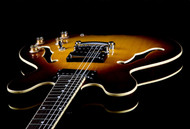How to Choose the Right Strings for Your Electric Guitar
Sep 18th 2023

How to Choose the Right Strings for Your Electric Guitar
Without strings, even the finest Les Paul or the perfect Strat is just a decoration. But there’s a lot more to it than just grabbing the first strings you see. We’ve seen it time and again: one guitarist loves a set of strings and another immediately wants to toss those same strings in the trash.
Picking out electric guitar strings is a mix of science and art. Although many things influence the string’s volume, tone, playability and durability, it ultimately comes down to what feels and sounds right. We want everyone to own the best electric guitar strings to live out their musical dreams, so use this guide to help you decide on a good fit.
Electric Guitar String Gauges
How important is this topic? Our very first reference guide was about string gauges for electric guitars. We’ll give you the SparkNotes version here, but make sure to read the full article for more information.
The basic idea is that the larger the string gauge is, the bigger the diameter. This changes how the guitar sounds and the neck tension. Each manufacturer has their own offerings, but for general reference, here’s a list of some Fender electric guitar gauge sets:
- Light: 0.009, 0.011, 0.016, 0.024, 0.032, 0.042
- Regular: 0.010, 0.013, 0.017, 0.026, 0.036, 0.046
- Medium: 0.011, 0.014, 0.018, 0.028, 0.038, 0.049
- Heavy: 0.012, 0.016, 0.024w, 0.032, 0.042, 0.052

Typically, rockers, “shredders” and beginners use lighter string gauges while blues, country and jazz guitarists use heavier string gauges. Lighter strings are brighter, have more punch, and are easier to bend, fingerpick and fret. On the other hand, they break more easily and the tuning isn’t as stable. Heavier strings have a warmer, fuller sound and can be played aggressively. They’re also better for alternate tunings and drop-tunings. Regular strings are considered a good all-around string that suits most styles.
If you play multiple genres, or frequently switch between lead and rhythm work, you might consider hybrid gauge guitar strings. They’re lighter on strings 1-3 for precise solo work and heavier on strings 4-6 for attacking rhythm parts. An example is the Ernie Ball Skinny Top/Heavy Bottom set.
Finally, remember that if you are switching to a different string gauge, you may need to make neck and bridge adjustments. The change in string tension affects intonation and tuning, and it can even cause fret buzz on lighter strings if left unchecked.
How Electric Guitar Strings Are Made
Once you’ve decided how thick you want your strings, you need to look at the design. There are many ways to build a guitar string, and each has its devotees. Use this section to help you sort through the many options.

String Core
Let’s start at the inside and work our way out. The core of an electric guitar string is almost always made of steel. You can choose between a hex core or a round core. Hex cores — which, big surprise, are shaped like a hexagon — are better at holding onto the top layer. This results in stiffer strings with a brighter sound and are more consistent over the string’s life. Round core strings are an older design that produces a more balanced “vintage” sound for jazz and old-school rock. They’re more flexible as well for bending.
Guitar String Material Wraps
Next, consider what material is wound around the core. Most electric strings use plain steel for the top three strings (G, B and high-E), and some use it for the bottom three strings, too. This can be a drawn carbon steel alloy specially made for musical instruments (it’s also found in pianos) or stainless steel. Both give you a very bright, sharp tone for rock and metal. Stainless steel also has natural corrosion resistance ideal for frequent players and hot, humid environments.
The prevalent winding materials are nickel-plated steel and nickel-steel alloy. The sound is a bit more mellow than pure steel but still bright enough for most players. Other strings you’ll find include:
- Pure Nickel: Warm, full-bodied and smooth-sounding strings for vintage guitars or to reign in your piece’s natural brightness.
- Cobalt: Bright, long-lasting strings that have a wider dynamic range than steel and are easier on your fingers.
- Chrome and Stainless Steel: Even brighter and harder-attacking than cobalt.
- Zinc-Plated Steel: Also known as galvanized steel, these strings have extra corrosion resistance.
Winding Types
The way the string material is wound also plays into the sound. You can get round-wound, flat-wound or half-round electric guitar strings. Round-wound strings are wrapped using cylindrical wire that gives you a bright tone, traditional feel and good attack and sustain. Flat-wound strings are made with ribbon-like wire wrapping, resulting in a dark tone and smooth feel preferred among jazz players. Half-round or ground-wound strings start as round-wound and are then ground down to eliminate the ridges. They’re partway between round- and flat-wound in terms of tone, sustain and feel.
Coated Electric Guitar Strings
Finally, you can get electric guitar
strings that have a polymer coating over the winding material.
Treated strings were invented by Elixir and are now also offered by D’Addario,
Cleartone, GHS and many other companies. The coating resists
corrosion so you get a longer-lasting, more consistent string, but it also
somewhat dampens the tone. Multiple
coating levels help you find the balance between longevity and brightness.

There are lots of good electric guitar strings out there, so it’s important to do some homework — and most importantly, try strings out until you find the ones that are perfect for your axe. We have a huge selection of electric guitar strings at discounted prices so you can afford to experiment. Call us at 1-877-830-0722 whenever you need help.

